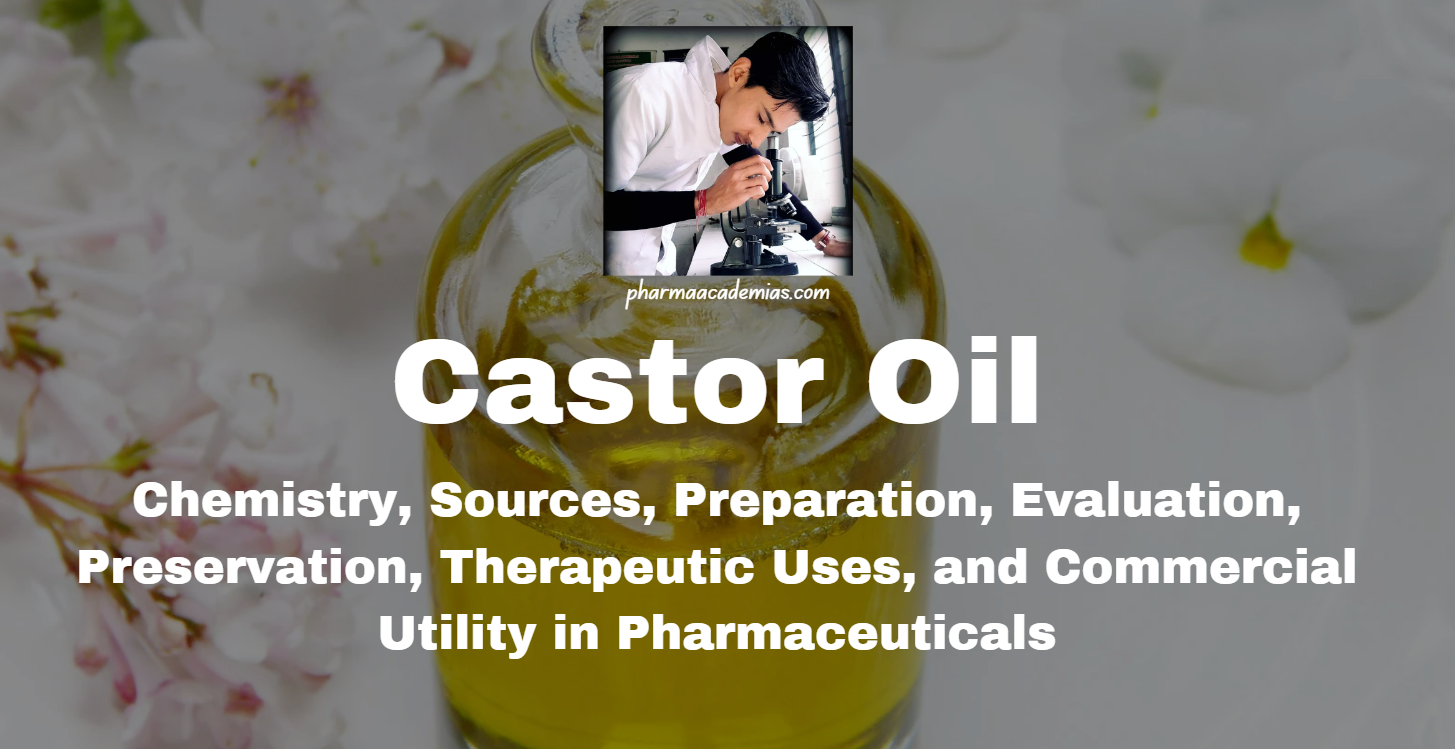General Introduction:
Castor oil is a vegetable oil obtained from the seeds of the castor plant (Ricinus communis). It has been used for centuries for its therapeutic properties and is a vital component in many industrial and pharmaceutical applications. Its unique chemical composition and versatility make it a valuable natural product.

Chemistry of Castor Oil
Chemical Composition: Castor oil is primarily composed of ricinoleic acid, a monounsaturated, 18-carbon fatty acid. Other components include oleic acid, linoleic acid, stearic acid, and palmitic acid.
Physical Properties: It is a pale yellow liquid with a distinct odor and a viscous consistency. It is soluble in alcohol but insoluble in water.
Chemical Properties: Castor oil is unique due to the presence of hydroxyl groups on the ricinoleic acid, contributing to its high viscosity and solubility in alcohols.
Sources of Castor Oil
Natural Source: Castor oil is extracted from the seeds of the castor plant, which is cultivated in tropical and subtropical regions worldwide.
Geographical Distribution: Major producers include India, Brazil, and China.
Extraction Methods of Castor Oil
Cold Pressing: Involves mechanically pressing the seeds without heat, preserving the oil’s natural properties.
Solvent Extraction: Uses solvents like hexane to extract the oil, followed by solvent removal.
Refining: The crude oil undergoes refining to remove impurities, resulting in pharmaceutical-grade castor oil.
Evaluation of Castor Oil
Quality Control: Castor oil is evaluated for its purity, viscosity, refractive index, specific gravity, and acid value.
Standards: Pharmaceutical castor oil must meet standards set by pharmacopeias like the USP (United States Pharmacopeia) and BP (British Pharmacopoeia).
Preservation and Storage of Castor Oil
Storage Conditions: Castor oil should be stored in a cool, dark place in tightly sealed containers to prevent oxidation and rancidity.
Preservation Methods: Antioxidants such as tocopherols may be added to enhance shelf life.
Therapeutic Uses of Castor Oil
Laxative: Castor oil is commonly used as a stimulant laxative, promoting bowel movements by irritating the intestinal lining.
Anti-inflammatory: Its anti-inflammatory properties make it useful in treating conditions like arthritis and muscle pain.
Skin Health: It is used topically to treat skin conditions such as acne, dermatitis, and wounds due to its antimicrobial properties.
Hair Care: Castor oil is used to promote hair growth and treat scalp infections.
Commercial Utility as Pharmaceutical Aids and/or Medicines:
Pharmaceutical Formulations: Castor oil is used as an excipient in the formulation of various pharmaceutical products, including capsules, ointments, and creams.
Lubricant: It is employed as a lubricant in pharmaceutical machinery.
Carrier Oil: Castor oil serves as a carrier for drug delivery in transdermal patches and topical medications.
Emulsifying Agent: It acts as an emulsifying agent in the production of emulsions and creams.
Conclusion:
Castor oil is a versatile and valuable natural product with a wide range of applications in pharmaceuticals and other industries. Its unique chemical properties, coupled with its therapeutic benefits, make it an essential component in various formulations and treatments. Proper evaluation, preservation, and storage are crucial to maintaining its quality and efficacy, ensuring its continued utility as a pharmaceutical aid and medicine.
Check this: Pharmacareerinsider.com

